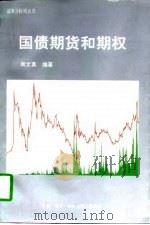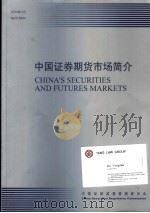《哈佛商学经典 期权、期货和衍生证券:英文》
| 作者 | (美)赫尔(Hull.J.C.)著 编者 |
|---|---|
| 出版 | 北京:华夏出版社 |
| 参考页数 | 572 |
| 出版时间 | 1998(求助前请核对) 目录预览 |
| ISBN号 | 750801457X — 求助条款 |
| PDF编号 | 810127908(仅供预览,未存储实际文件) |
| 求助格式 | 扫描PDF(若分多册发行,每次仅能受理1册) |

1 INTRODUCTION1
1.1 Forward Contracts1
1 INTRODUCTION1
1.2 Futures Contracts3
1.3 Options4
1.4 Other Derivatives9
1.5 Types of Traders10
Questions and Problems13
1.6 Summary13
2.1 Trading Futures Contracts16
2 FUTURES MARKETS AND THE USE OF FUTURES FOR HEDGING16
2 FUTURES MARKETS AND THE USE OF FUTURES FOR HEDGING16
2.2 Specification of the Futures Contract17
2.3 Operation of Margins20
2.4 Newspaper Quotes24
2.5 Convergence of Futures Price to Spot Price28
2.6 Settlement29
2.7 Regulation30
2.8 Hedging Using Futures31
2.9 Optimal Hedge Ratio35
2.10 Rolling the Hedge Forward37
2.11 Accounting and Tax38
2.12 Summary40
Suggestions for Further Reading41
Questions and Problems42
3 FORWARD AND FUTURES PRICES45
3.1 Some Preliminaries45
3 FORWARD AND FUTURES PRICES45
3.2 Forward Contracts on a Security That Provides No Income51
3.3 Forward Contracts on a Security That Provides a Known Cash Income52
3.4 Forward Contracts on a Security That Provides a Known Dividend Yield54
3.6 Forward Prices versus Futures Prices55
3.5 General Result55
3.7 Stock Index Futures57
3.8 Forward and Futures Contracts on Currencies63
3.9 Futures on Commodities65
3.10 The Cost of Carry67
3.11 Delivery Choices68
3.12 Futures Prices and the Expected Future Spot Price68
3.13 Summary71
Suggestions for Further Reading72
Questions and Problems73
Appendix 3A Proof That Forward and Futures Prices Are Equal When Interest Rates Are Constant76
4 INTEREST RATE FUTURES78
4.1 Some Preliminaries78
4 INTEREST RATE FUTURES78
4.2 Forward Rate Agreements87
4.3 Treasury Bond and Treasury Note Futures88
4.4 Treasury Bill Futures95
4.5 Eurodollar Futures99
4.6 Duration100
4.7 Duration-Based Hedging Strategies102
4.8 Limitations of Duration104
4.9 Summary106
Suggestions for Further Reading107
Questions and Problems107
5 SWAPS111
5.1 Mechanics of Interest Rate Swaps111
5 SWAPS111
5.2 The Comparative Advantage Argument118
5.3 Valuation of Interest Rate Swaps121
5.4 Currency Swaps125
5.5 Valuation of Currency Swaps128
5.6 Other Swaps130
5.7 Credit Risk132
5.8 Summary133
Suggestions for Further Reading134
Questions and Problems134
6 OPTIONS MARKETS138
6.1 Exchange-Traded Options138
6 OPTIONS MARKETS138
6.2 Over-the-Counter Options139
6.3 Specification of Stock Options140
6.4 Newspaper Quotes145
6.5 Trading146
6.6 Commissions147
6.7 Margins148
6.8 The Options Clearing Corporation150
6.9 Regulation151
6.10 Taxation151
6.11 Warrants and Convertibles153
6.12 Summary154
Suggestions for Further Reading154
Questions and Problems154
7 PROPERTIES OF STOCK OPTION PRICES156
7.1 Factors Affecting Option Prices156
7 PROPERTIES OF STOCK OPTION PRICES156
7.2 Assumptions and Notation158
7.3 Upper and Lower Bounds for Option Prices159
7.4 Early Exercise:Calls on a Non-Dividend-Paying Stock162
7.5 Early Exercise:Puts on a Non-Dividend-Paying Stock165
7.6 Put-Call Parity167
7.7 Effect of Dividends170
7.8 Empirical Research172
7.9 Summary173
Suggestions for Further Reading174
Questions and Problems174
8 TRADING STRATEGIES INVOLVING OPTIONS177
8.1 Strategies Involving a Single Option and a Stock177
8 TRADING STRATEGIES INVOLVING OPTIONS177
8.2 Spreads179
8.3 Combinations187
8.4 Other Payoffs190
8.5 Summary190
Suggestions for Further Reading191
Questions and Problems192
9 INTRODUCTION TO BINOMIAL TREES194
9.1 One-Step Binomial Model194
9 INTRODUCTION TO BINOMIAL TREES194
9.2 Risk-Neutral Valuation198
9.3 Two-Step Binomial Trees199
9.4 Put Example202
9.5 American Options203
9.6 Delta204
9.7 Using Binomial Trees in Practice205
9.8 Summary206
Suggestions for Further Reading207
Questions and Problems207
10 MODEL OF THE BEHAVIOR OF STOCK PRICES209
10.1 The Markov Property209
10 MODEL OF THE BEHAVIOR OF STOCK PRICES209
10.2 Wiener Processes210
10.3 The Process for Stock Prices215
10.4 Review of the Model217
10.5 The Parameters219
10.6 Ito s Lemma220
10.7 Summary222
Questions and Problems223
Suggestions for Further Reading223
Appendix 10A Derivation of Ito s Lemma225
11 THE BLACK-SCHOLES ANALYSIS228
11.1 Lognormal Property of Stock Prices228
11 THE BLACK-SCHOLES ANALYSIS228
11.2 The Distribution of the Rate of Return230
11.3 Estimating Volatility form Historical Data232
11.4 Concepts Underlying the Black-Scholes Differential Equation235
11.5 Derivation of the Black-Scholes Differential Equation237
11.6 Risk-Neutral Valuation239
11.7 Black-Scholes Pricing Formulas240
11.8 Cumulative Normal Distribution Function243
11.9 Warrants Issued by a Company on Its Own Stock244
11.10 Implied Volatilities246
11.11 The Causes of Volatility247
11.12 Dividends249
11.13 Summary253
Suggestions for Further Reading255
Questions and Problems256
Appendix 11A Exact Procedure for Calculating Values of American Calls on Dividend-Paying Stocks259
Appendix 11B Calculation of Cumulative Probability in Bivariate Normal Distribution260
12 OPTIONS ON STOCK INDICES, CURRENCIES, AND FUTURES CONTRACTS261
12 OPTIONS ON STOCK INDICES, CURRENCIES, AND FUTURES CONTRACTS261
12.1 Extending Black-Scholes261
12.2 Pricing Formulas263
12.3 Options on Stock Indices264
12.4 Currency Options269
12.5 Futures Options273
12.6 Summary280
Suggestions for Further Reading281
Questions and Problems282
Appendix 12A Derivation of Differential Equation Satisfied by a Derivative Dependent on a Stock Paying a Continuous Dividend Yield284
Appendix 12B Derivation of Differential Equation Satisfied by a Derivative Dependent on a Futures Price286
13 GENERAL APPROACH TO PRICING DERIVATIVES288
13 GENERAL APPROACH TO PRICING DERIVATIVES288
13.1 Single Underlying Variable288
13.2 Interest Rate Risk292
13.3 Securities Dependent on Several State Variables293
13.4 Is It Necessary to Estimate the Market Price of Risk?296
13.5 Derivatives Dependent on Commodity Prices297
13.6 Quantos298
13.7 Summary302
Suggestions for Further Reading302
Questions and Problems303
Appendix 13A Generalization of Ito s Lemma304
Appendix 13B Derivation of the General Differential Equation Satisfied by Derivatives305
14 THE MANAGEMENT OF MARKET RISK308
14.1 Example308
14 THE MANAGEMENT OF MARKET RISK308
14.2 Naked and Covered Positions309
14.3 A Stop-Loss Strategy310
14.4 More Sophisticated Hedging Schemes312
14.5 Delta Hedging312
14.6 Theta321
14.7 Gamma323
14.8 Relationship among Delta, Theta, and Gamma327
14.9 Vega328
14.10 Rho330
14.11 Scenario Analysis331
14.12 Portfolio Insurance333
14.13 Summary337
Suggestions for Further Reading338
Questions and Problems339
Appendix 14A Taylor Series Expansions and Hedge Parameters342
15 NUMERICAL PROCEDURES343
15.1 Binomial Trees343
15 NUMERICAL PROCEDURES343
15.2 Using the Binomial Tree for Options on Indices, Currencies, and Futures Contracts350
15.3 Binomial Model for a Dividend-Paying Stock352
15.4 Extensions of the Basic Tree Approach356
15.5 Alternative Procedures for Constructing Trees358
15.6 Monte Carlo Simulation361
15.7 Variance Reduction Procedures365
15.8 Finite Difference Methods368
15.9 Analytic Approximations in Option Pricing379
15.10 Summary380
Suggestions for Further Reading381
Questions and Problems382
Appendix 15A Analytic Approximation to American Option Prices of Macmillan, and Barone-Adesi and Whaley384
16 INTEREST RATE DERIVATIVES AND THE USE OF BLACK S MODEL387
16.1 Exchange-Traded Interest Rate Options387
16 INTEREST RATE DERIVATIVES AND THE USE OF BLACK S MODEL387
16.2 Embedded Bond Options389
16.3 Mortgage-Backed Securities389
16.4 Option-Adjusted Spread391
16.5 Black s Model392
16.6 European Bond Options395
16.7 Interest Rate Caps397
16.8 European Swap Options401
16.9 Accrual Swaps404
16.10 Spread Options405
16.11 Convexity Adjustments406
16.12 Summary411
Suggestions for Further Reading412
Questions and Problems412
Appendix 16A Proof of the Convexity Adjustment Formula414
17 INTEREST RATE DERIVATIVES AND MODELS OF THE YIELD CURVE416
17.1 Introduction to Equilibrium Models416
17 INTEREST RATE DERIVATIVES AND MODELS OF THE YIELD CURVE416
17.2 One-Factor Models417
17.3 The Rendleman and Bartter Model418
17.4 The Vasicek Model419
17.5 The Cox, Ingersoll, and Ross Model422
17.6 Two-Factor Models423
17.7 Introduction to No-Arbitrage Models424
17.8 Modeling Forward Rates428
17.9 Developing Markov Models431
17.10 Ho and Lee Model431
17.11 Hull and White Model433
17.12 Interest Rate Trees436
17.13 A General Tree-Building Procedure438
17.14 Nonstationary Models449
17.15 Forward Rates and Futures Rates450
17.16 Summary452
Suggestions for Further Reading453
Questions and Problems454
18 EXOTIC OPTIONS457
18.1 Types of Exotic Options457
18 EXOTIC OPTIONS457
18.3 Path-Dependent Derivatives469
18.2 Basic Numerical Procedures469
18.4 Lookback Options474
18.5 Barrier Options476
18.6 Options on Two Correlated Assets480
18.7 Hedging Issues482
18.8 Static Options Replication483
18.9 Summary485
Suggestions for Further Reading486
Questions and Problems487
19 ALTERNATIVES TO BLACK-SCHOLES FOR OPTION PRICING490
19.1 Known Changes in the Interest Rate and Volatility490
19 ALTERNATIVES TO BLACK-SCHOLES FOR OPTION PRICING490
19.2 Merton s Stochastic Interest Rate Model491
19.3 Pricing Biases492
19.4 Alternative Models494
19.5 Overview of Pricing Biases499
19.6 Stochastic Volatility499
19.7 How Black-Scholes Is Used in Practice502
19.8 Implied Trees505
19.9 Empirical Research507
19.10 Summary510
Suggestions for Further Reading511
Questions and Problems512
Appendix 19A Pricing Formulas for Altemative Models514
20 CREDIT RISK AND REGULATORY CAPITAL517
20 CREDIT RISK AND REGULATORY CAPITAL517
20.1 Background518
20.2 Adjusting the Prices of Options for Credit Risk521
20.3 Contracts That Can Be Assets or Liabilities523
20.4 Historical Default Experience527
20.5 Valuation of Convertible Bonds528
20.6 The BIS Capital Requirements531
20.7 Reducing Exposure to Credit Risk534
20.8 Summary535
Suggestions for Further Reading536
Questions and Problems536
21.1 Riskless Hedges539
21 REVIEW OF KEY CONCEPTS539
21 REVIEW OF KEY CONCEPTS539
21.2 Traded Securities versus Other Underlying Variables540
21.3 Risk-Neutral Valuation540
21.4 Those Big Losses541
21.5 A Final Word541
MAJOR EXCHANGES543
GLOSSARY OF NOTATION545
TABLE FOR N(x)WHENx≤0548
TABLE FOR N(x)WHENx≥0549
AUTHOR INDEX551
SUBJECT INDEX555
1998《哈佛商学经典 期权、期货和衍生证券:英文》由于是年代较久的资料都绝版了,几乎不可能购买到实物。如果大家为了学习确实需要,可向博主求助其电子版PDF文件(由(美)赫尔(Hull.J.C.)著 1998 北京:华夏出版社 出版的版本) 。对合法合规的求助,我会当即受理并将下载地址发送给你。
高度相关资料
-

- 现代证券与期货
- 1995 青岛:青岛出版社
-

- 世界期货与证券市场 下
- 1990
-

- 世界期货与证券市场 中
- 1990
-

- 世界期货与证券市场 上
- 1990
-

- 期权期货和衍证卷
- 1997 北京:华夏出版社
-

- 法国证券、期货交易法律
- 1999 北京:法律出版社
-

- 期货投资和期权
- 1999 南京:南京大学出版社
-

- 证券与期货业务电算化
- 1996 长沙:湖南师范大学出版社
-

- 英汉证券期货词典
- 1997 上海:上海社会科学院出版社
-

- 国债期货和期权
- 1997 上海:上海三联书店
-

- 证券与期货基础
- 1998 北京:中国商业出版社
-

- 证券与期货
- 1996 北京:中国商业出版社
-

- 12小时哈佛商学经典
- 1997 北京市:中国友谊出版公司
-

- 证券期货法教程
- 1998 北京:中国财政经济出版社
提示:百度云已更名为百度网盘(百度盘),天翼云盘、微盘下载地址……暂未提供。➥ PDF文字可复制化或转WORD
